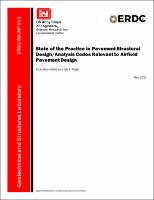Please use this identifier to cite or link to this item:
https://hdl.handle.net/11681/40542Full metadata record
| DC Field | Value | Language |
|---|---|---|
| dc.contributor.author | Heymsfield, Ernest | - |
| dc.contributor.author | Tingle, Jeb S. | - |
| dc.date.accessioned | 2021-05-10T15:56:34Z | - |
| dc.date.available | 2021-05-10T15:56:34Z | - |
| dc.date.issued | 2021-05 | - |
| dc.identifier.govdoc | ERDC/GSL MP-21-1 | - |
| dc.identifier.uri | https://hdl.handle.net/11681/40542 | - |
| dc.identifier.uri | http://dx.doi.org/10.21079/11681/40542 | - |
| dc.description | Miscellaneous Paper | en_US |
| dc.description.abstract | An airfield pavement structure is designed to support aircraft live loads for a specified pavement design life. Computer codes are available to assist the engineer in designing an airfield pavement structure. Pavement structural design is generally a function of five criteria: the pavement structural configuration, materials, the applied loading, ambient conditions, and how pavement failure is defined. The two typical types of pavement structures, rigid and flexible, provide load support in fundamentally different ways and develop different stress distributions at the pavement – base interface. Airfield pavement structural design is unique due to the large concentrated dynamic loads that a pavement structure endures to support aircraft movements. Aircraft live loads that accompany aircraft movements are characterized in terms of the load magnitude, load area (tire-pavement contact surface), aircraft speed, movement frequency, landing gear configuration, and wheel coverage. The typical methods used for pavement structural design can be categorized into three approaches: empirical methods, analytical (closed-form) solutions, and numerical (finite element analysis) approaches. This article examines computational approaches used for airfield pavement structural design to summarize the state-of-the-practice and to identify opportunities for future advancements. United States and non-U.S. airfield pavement structural codes are reviewed in this article considering their computational methodology and intrinsic qualities. | en_US |
| dc.description.sponsorship | United States. Army. Corps of Engineers. | en_US |
| dc.format.extent | 18 pages / 1.11 MB | - |
| dc.format.medium | PDF/A | - |
| dc.language.iso | en_US | en_US |
| dc.publisher | Geotechnical and Structures Laboratory (U.S.) | en_US |
| dc.publisher | Engineer Research and Development Center (U.S.) | - |
| dc.relation.ispartofseries | Miscellaneous Paper (Engineer Research and Development Center (U.S.)) ; no. ERDC/GSL MP-21-1 | - |
| dc.relation.isversionof | Heymsfield, Ernie, and Jeb S. Tingle. "State of the practice in pavement structural design/analysis codes relevant to airfield pavement design." Engineering Failure Analysis 105 (2019): 12-24. https://doi.org/10.1016/j.engfailanal.2019.06.029 | - |
| dc.rights | Approved for Public Release; Distribution is Unlimited | - |
| dc.source | This Digital Resource was created in Microsoft Word and Adobe Acrobat | - |
| dc.subject | Rigid pavement design | en_US |
| dc.subject | Flexible pavement design | en_US |
| dc.subject | Pavement computer code | en_US |
| dc.subject | Pavement design | en_US |
| dc.title | State of the practice in pavement structural design/analysis codes relevant to airfield pavement design | en_US |
| dc.type | Report | en_US |
| Appears in Collections: | Miscellaneous Paper | |
Files in This Item:
| File | Description | Size | Format | |
|---|---|---|---|---|
| ERDC-GSL MP-21-1.pdf | 1.11 MB | Adobe PDF |  View/Open |